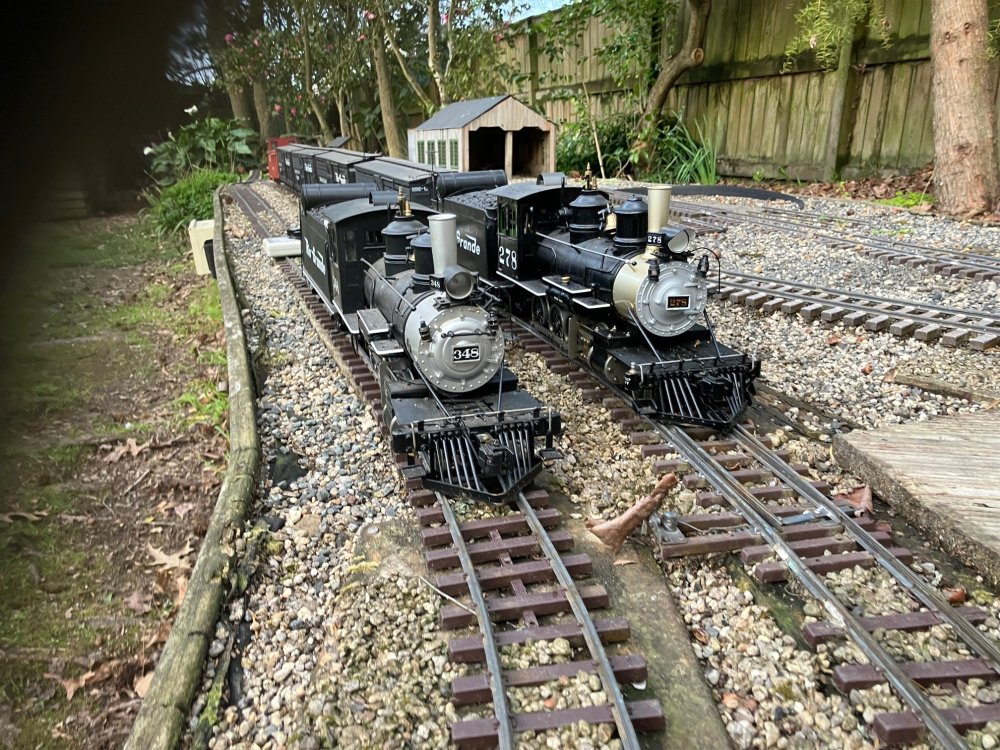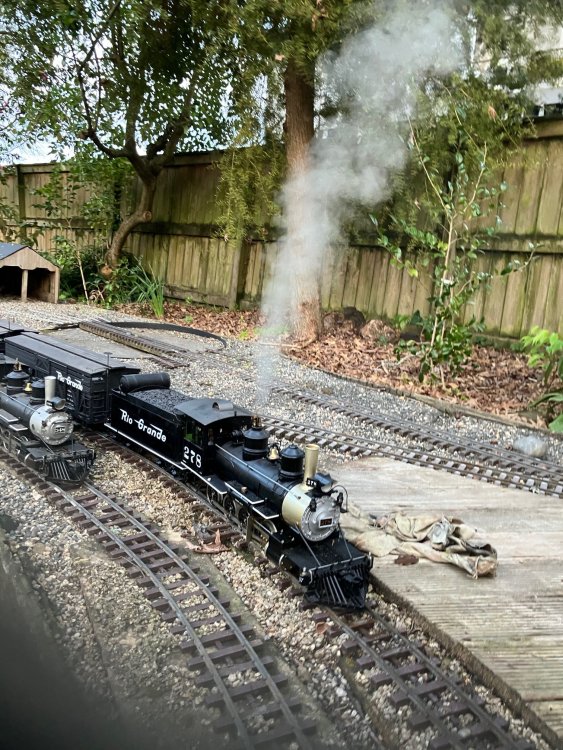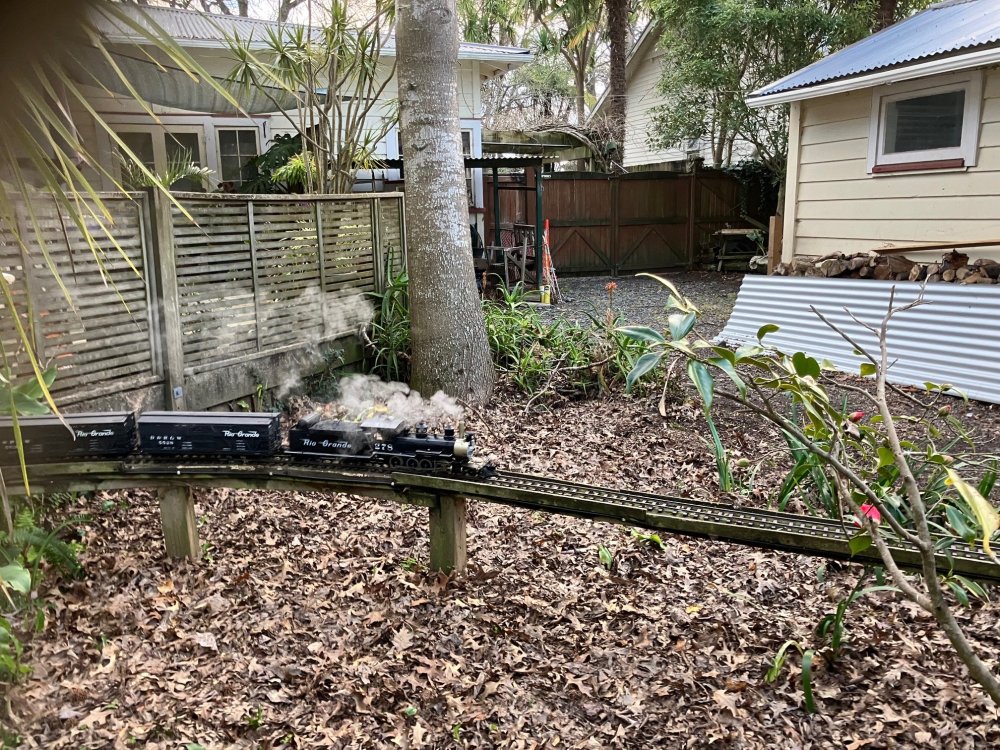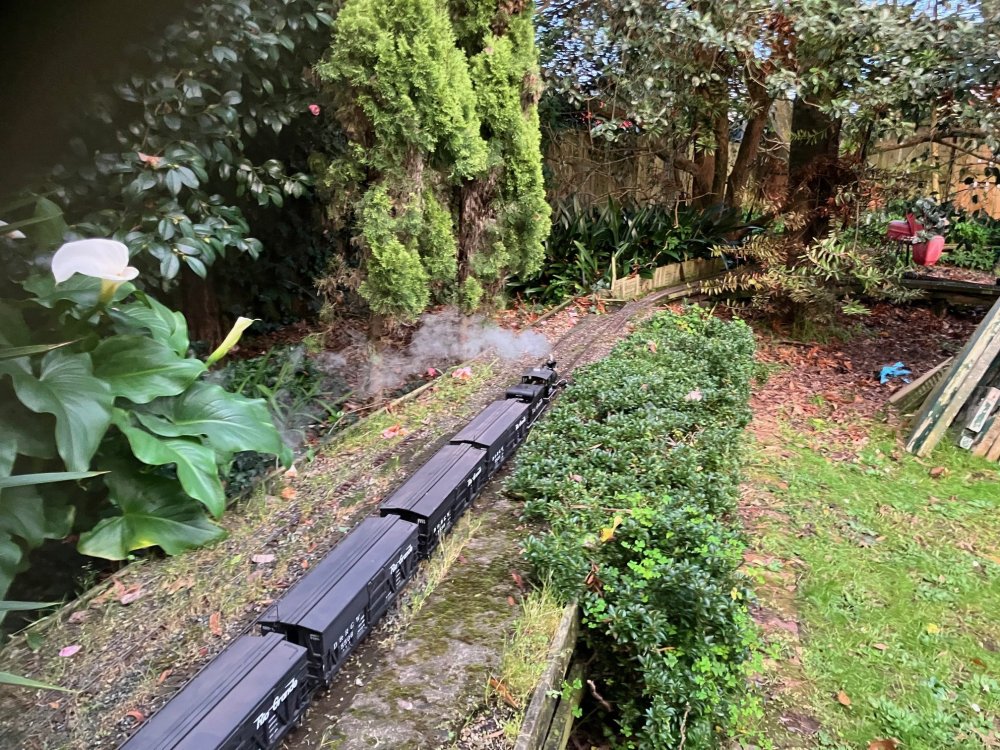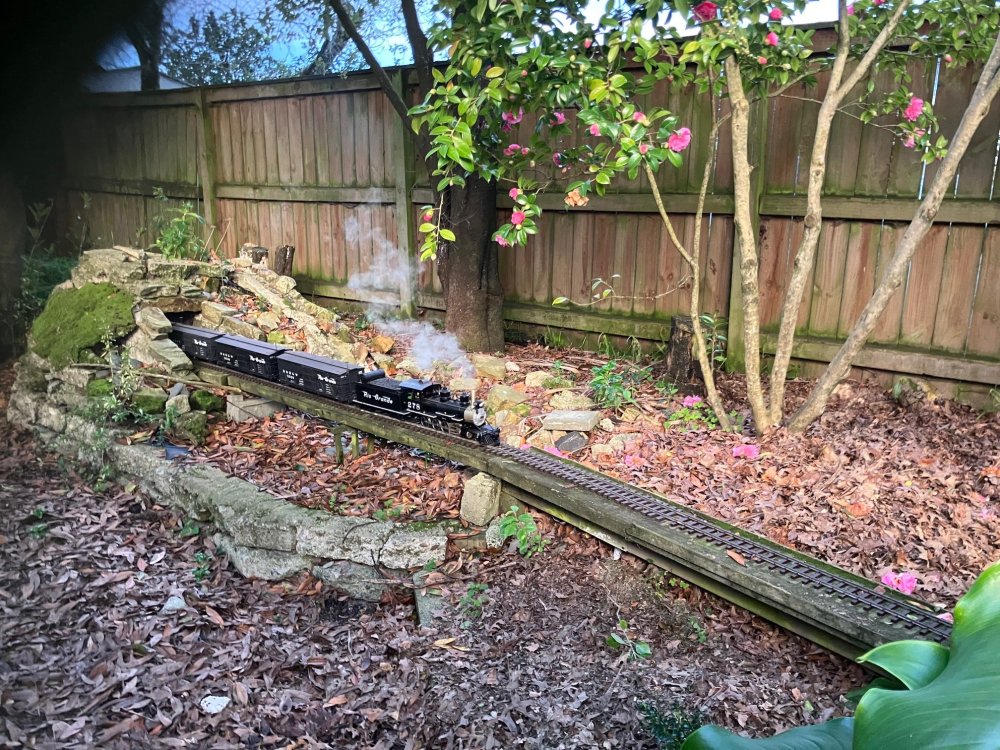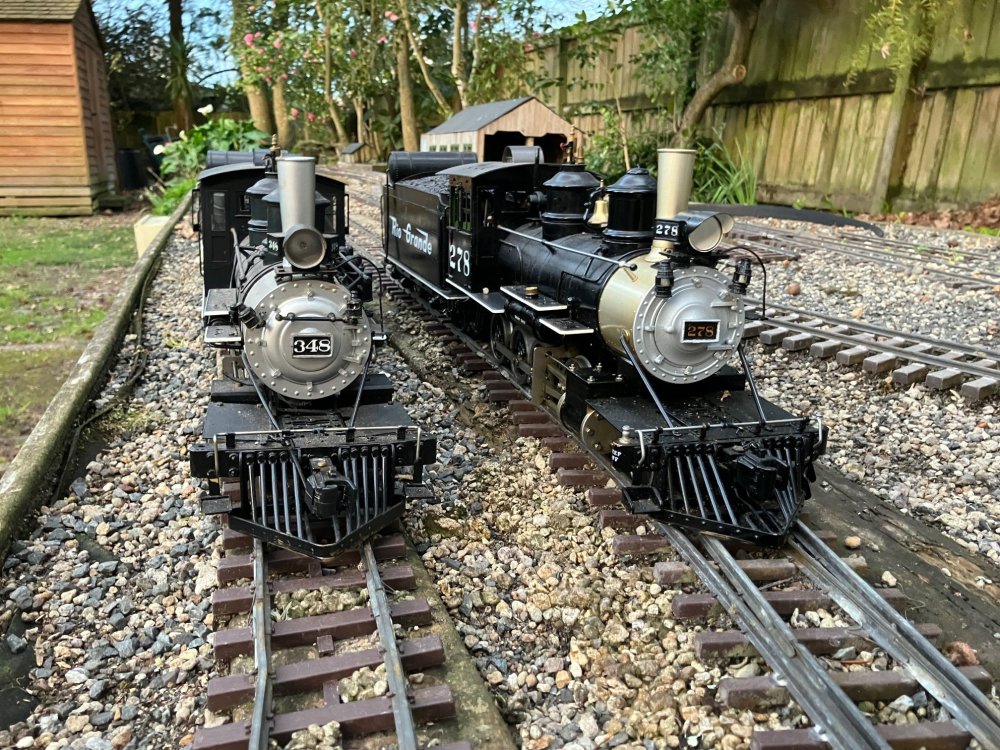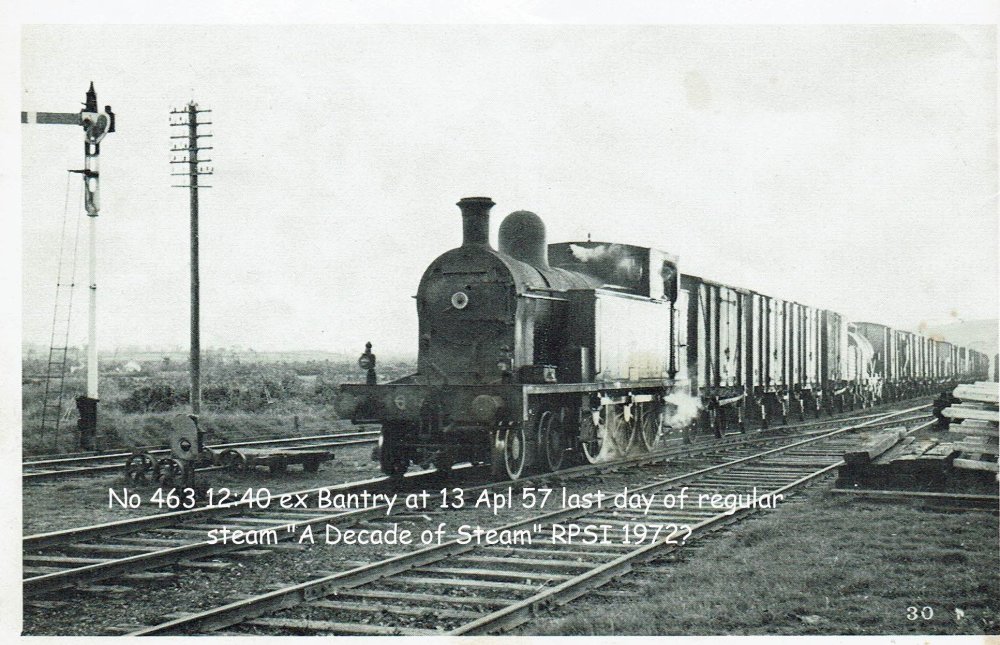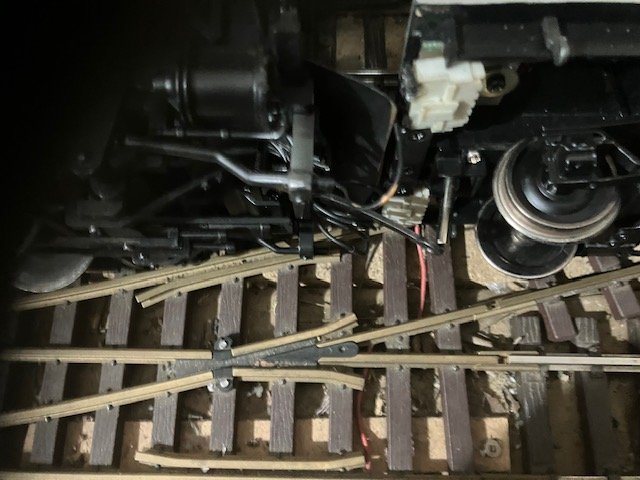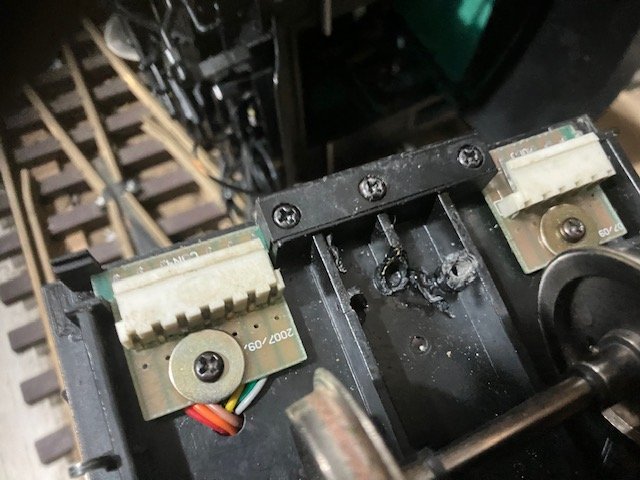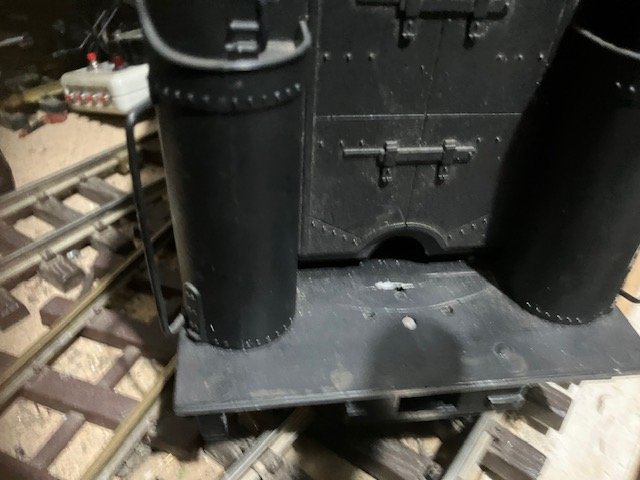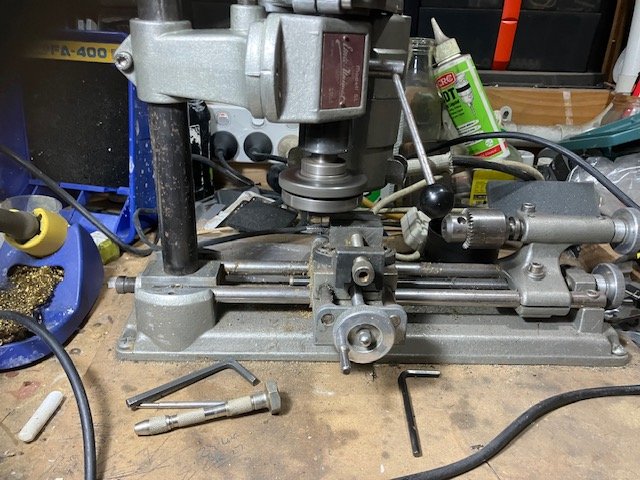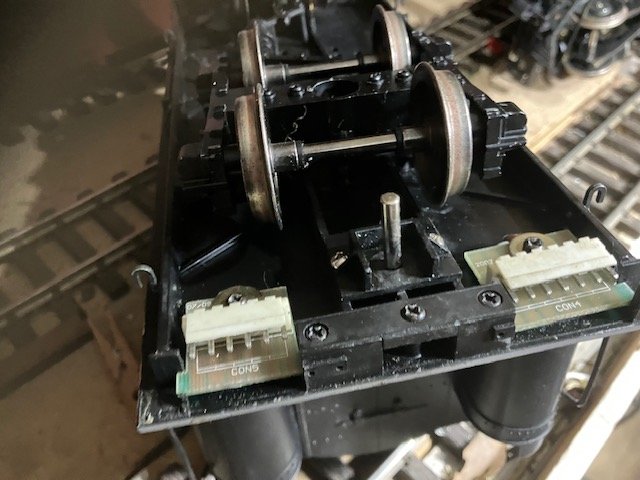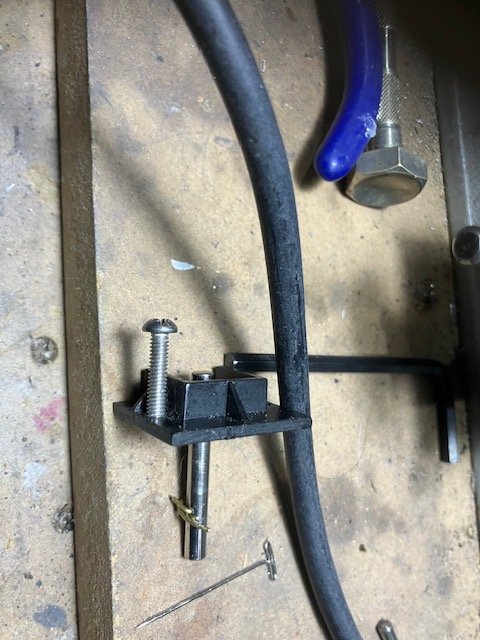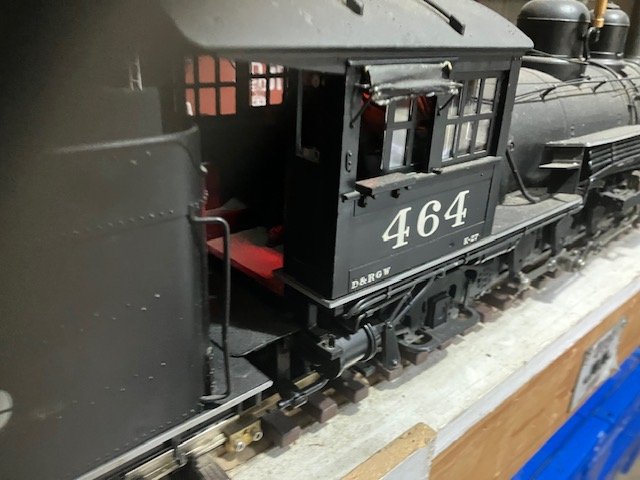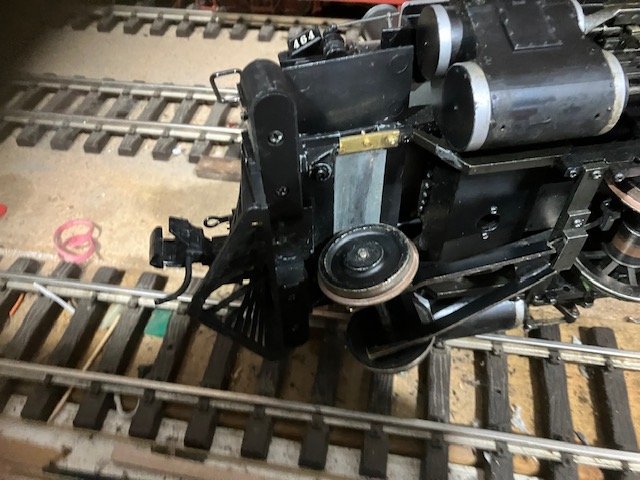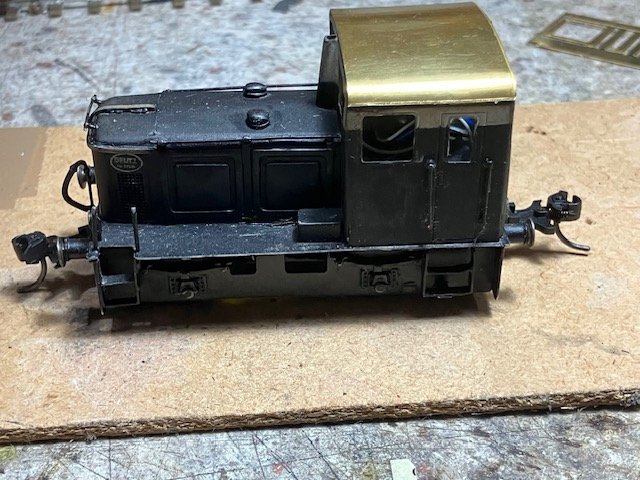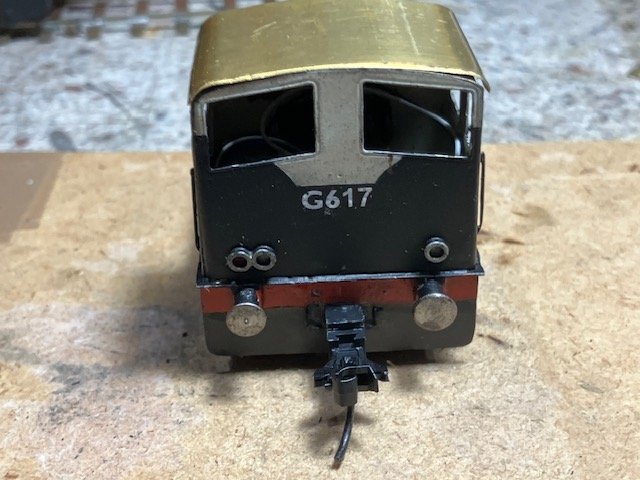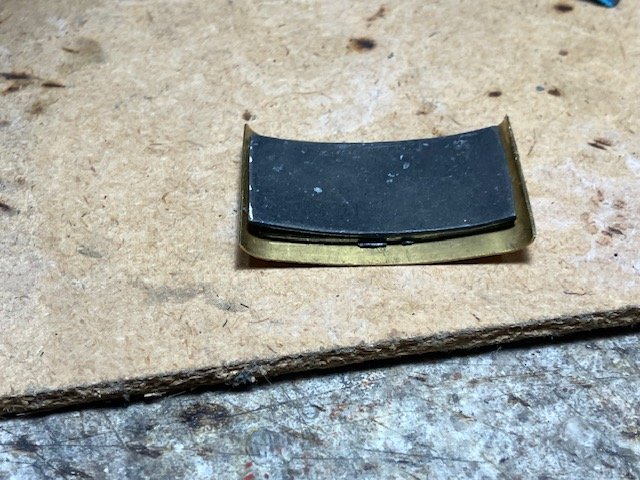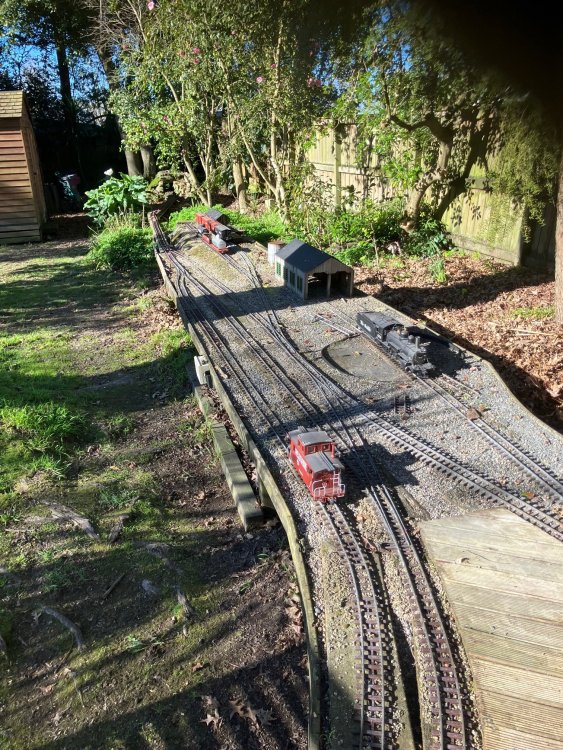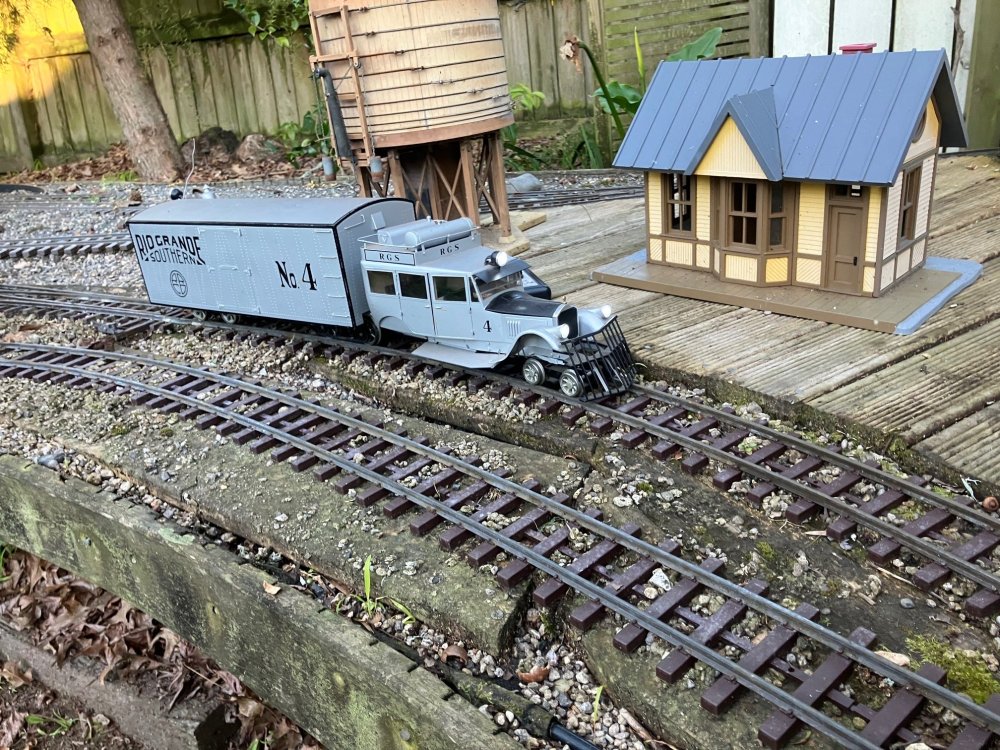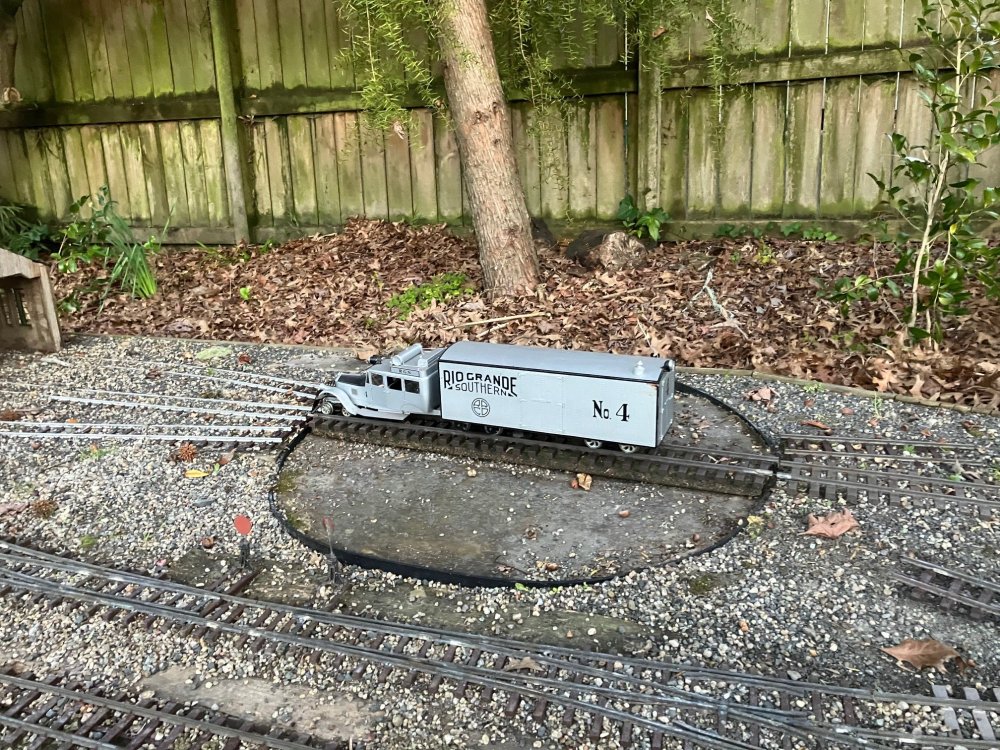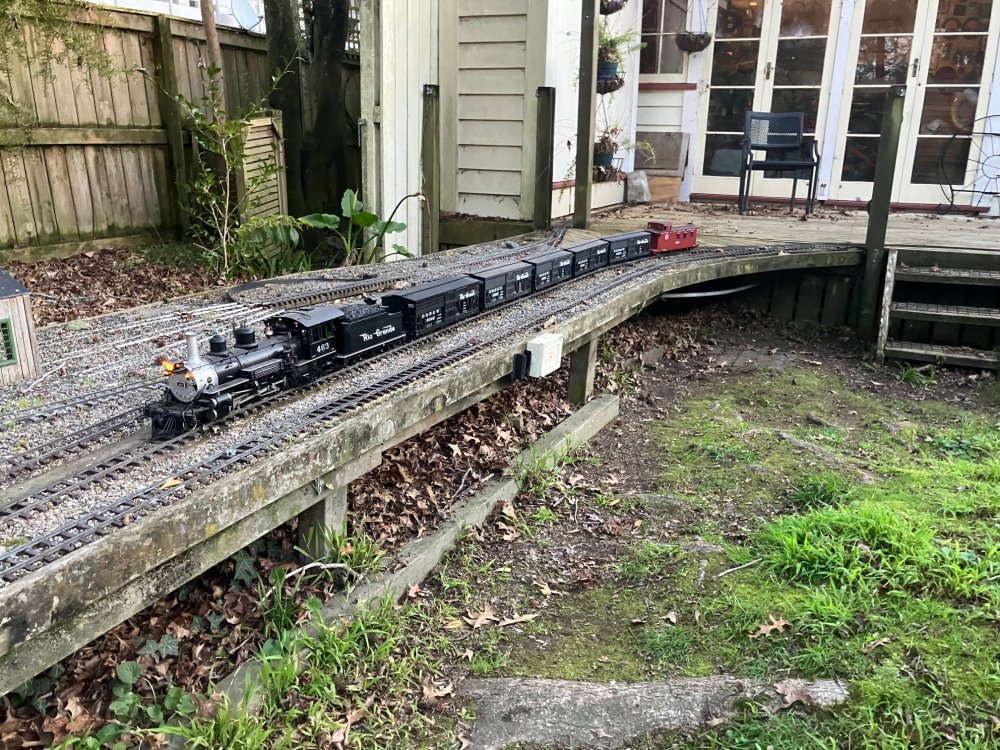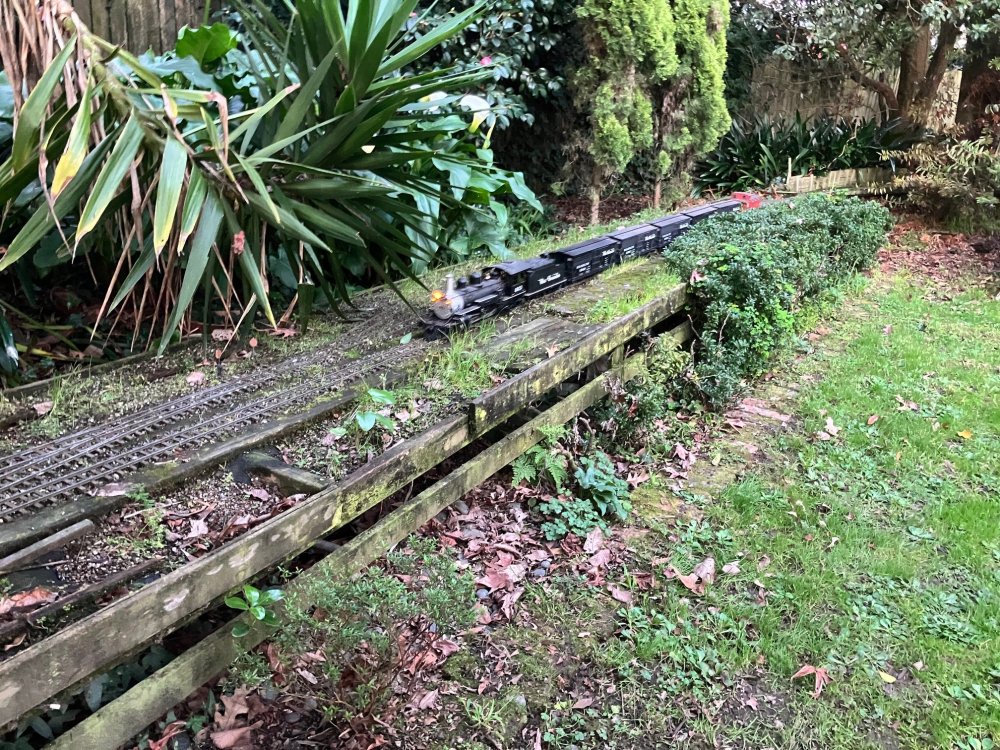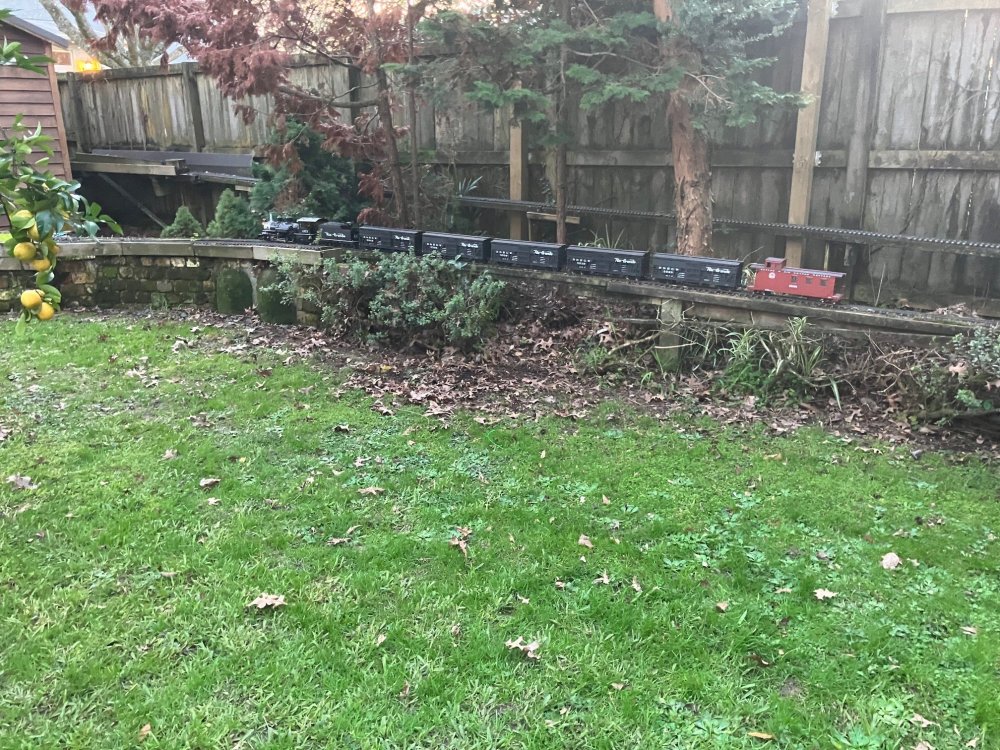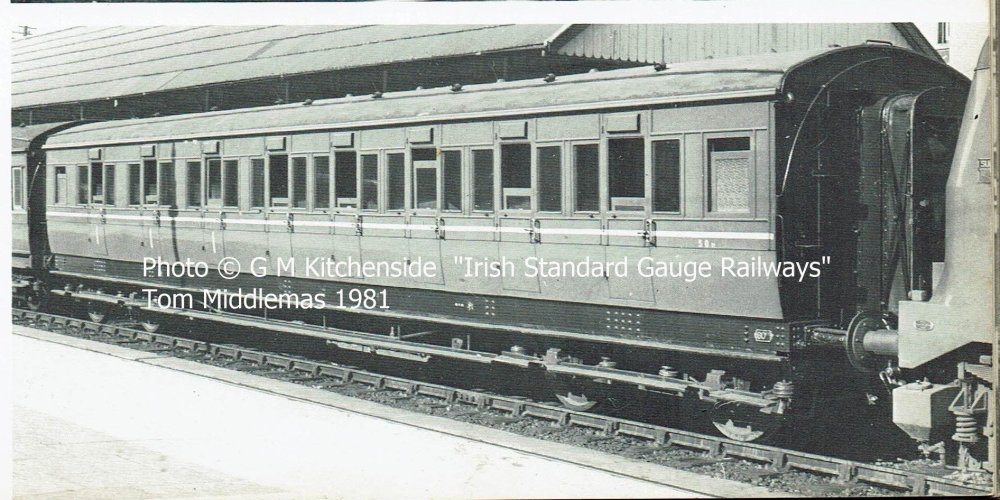-
Posts
4,871 -
Joined
-
Last visited
-
Days Won
119
Content Type
Profiles
Forums
Events
Gallery
Blogs
Store
Community Map
Everything posted by Mayner
-
Really like the station JHB really places the station in the Kingdom, tell us more! Edna's vans look the part right down to the friction axleboxes later replaced with roller bearing following problems with 'hot boxes" I wen't down a rabbit hole with the RTR 20T vans and ended up with 4 body variations and several livery/number iterations. I did produce a ply bodied version with modified duckets all my versions had planked balconies, came across one poor quality photo of a van with all ply body and balcony, the 30T vans had an all welded steel body.
-
Hi Paul Insufficient interest at this stage to complete complete sets of parts for the 51-53 Inchacore built coaches. The 60' etched sides can be supplied to order direct from PPD, I expect to have prices for sides only later in August. Sides produced were: (a) Buffet Car (b) 1372-78 Side Corridor Standard (c) 1356-1371 Open Standard (d) 1904-8 Brake Standard (e)3201-12 Brake Standard Steam Generator Van
-
Conyngham Road Depot used to be a regular stop on City/Ballybough bound No 23 bus services in the 60s & 70s while travelling with my Mum as a kid to visit her Aunts in Nth Richmond St and on my own as a teenager on visits to model(railway!) shops and the MRSI Clubroom also in Nth Richmond St!. The Conyngham Road Depot has a long history as a public transport depot, initially the Dublin & Lucan 3' gauge steam tramway Dublin Depot & works, the 3'6" gauge Lucan Electric Tramway absorbed by the DUTC and converted to Broad Gauge and integrated into Dublin's electric tramway system in the 1920s before the Lucan tramway services were replaced by buses in 1940s. The main concrete/masonry depot buildings likely to date from the DUTC era. Wasn't interested in the Busses or Conyngham Rd Depot but the top deck of the No 23 Bus most of the way from the Colbert Rd bridge to Conyngham Rd depot was a great for trainspotting (mainly shunting) Islandbridge Junction and Heuston Goods
-
"Tail Traffic" on AEC worked passenger trains on the Waterford-Limerick line into the late 60s. An IRRS Paper "A Day at the Junction" by Herman Sherman in one of the 1969 Journals details passenger and freight working on a day spent at the 'Junction" both the daily East and Westbound passenger trains between Waterford and Limerick were worked by 3 Car AEC railcar sets (2 powered+ intermediate coach) hauling 1-2 4w Flats carrying containers (possibly pre-ISO) most likely meat traffic from Limerick (possibly Rathkeale or Limerick) for export through Waterford. In the late 60s CIE transferred the majority of its AEC cars to Dublin to work the newly intergrated Howth-Bray suburban services over the newly installed North-South connections between the ex-GNR main line and the North Dublin Loop line in the East Wall Junction area. "A Day at the Junction" is well worth seeking out as along with info on locos, stock and train workings it includes railway (mainly) men's nicknames for various trains incl. "The Soup" prestigious express with dining car and others, I donated my collection of IRRS Journals when I left Ireland over 20 years ago, but have since run out of space to store them!
-
1. It looks like an Operator is required to Register with the IAA if they own a drone over 250kg or if it has a camera. https://www.iaa.ie/general-aviation/drones/drone-register. The requirement to register on the MySRS site triggers a requirement to complete on-line training and additionally; 2. even recreational use of a camera drone may be subject to privacy legislation as it may potentially be used to identify a 'natural person. 3. An important point 'Line of Sight' (VLOS) flight for drones that don't trigger a requirement for a "Remote Pilot Competency' cert is defined as the pilot being able to see the drone and its surroundings with their own eyes, i.e. without visual aids such as bionoculars, a monitor (I Phone, Android or other device) or headset. In this part of the world there is a requirement to obtain the owner/occupiers permission before flying a drone over private property. A drone operator could be potentially committing trespass if they enter private property in Ireland without the owners permission (incl IE's rail corridor or privately owned adjoining land)
-

Narrow Gauge in the Rockies not quite
Mayner replied to Mayner's topic in US / Canadian Railway Modelling
Saturday late afternoon was cold and sunny after a busy morning and a good opportunity to test how No 268s recently repainted smokebox door would stand up to the heat! Live steamDRGW C16 No 278 waits top take over Stock Train hauled from garden shed by battery powered No 348. Gas fired 278 scorched her smokebox door and front as a result of a "flare-up" in the smoke box several years ago, recently re-painted with a heat resistant auto aerosol silver and finished with a gloss lacquer, waiting light up for a test run. Steam raised safety valve blowing off at 60psi. Hoping to dress this section up as one of the famed RGS trestles atsome stage during the next couple of years, earlier this section had become quite overgrown, fallen leaves to be covered with mulch as annual weed control! Storage tracks in garage in background connect to the main circuit by the High Line on a 4% (1:25) grade. https://www.facebook.com/photo?fbid=10231966944890768&set=gm.1143872954049475&idorvanity=297689325334513 The railroad descends at 2% from the last photo highest part of the oval over a distance of 40' to the lowest point before climbing to the summit at a similar grade. Driving technique is to run down-grade with the steam almost shut off before opening up at full throttle to gain sufficient momentum to climb the curving 2% grade section towards the tunnel which begins by the timber retaining wall in the distance. Train has just about cleared the curving section to the tunnel and beginning to accellerate on the straightish section to the main yard. The train is crossing what was once a water feature fed from above the tunnel, but too much hassle to maintain because of leaf fall. Almost back at the starting point after 3 whole laps of the circuit 278 out of gas and low in water, no sign of scorching of smokebox door/front. I'll probabably give the loco a few more runs before deciding whether to give the smokebox and funnel a fresh coat of silver! Photo nicely shows up kink in rail on left, probably caused from walking over track! 278 had dropped her train at the end of the single line section outside of the year for 348 to collect. Both locos tend to struggle with 4 cars and a caboose on the final section of the circuit into the loop and 278 was too low in gas (boiler pressure) to make it into the loop with its train. Finished run after 5pm and put trains away by 5:30, topped up 278 boiler with water, drained condensate and topped up lubricator reservoir still light but bitter cold. 278 throttle (regulator) and reverser are manually controlled (scorched fingers) though I have parts to convert throttle to RC and the arthritis in my knees is beginning tp play up!! -
Only set foot in Nenagh as a 16-17 year old in 73-4 with my parents on the drive from Dublin to two weeks summer holiday in a caravan park in Kilkee, main recollection was the local skinheads with their cropped hair and 'bovver boot' wore standard cut jeans and denim jackets unlike our neighborhood skins and bootboys who wore half mast high cut jeans. To make the long story short we could not find anywhere to eat lunch in Nenagh or Limerick City all cafes/resturants were full on a busy Holiday Saturday and ended up with a very late lunch in Ennis. My father sometimes talked about into Dublin City Centre on a weekend to watch the fights (often with women) in the streets late at night in the 1940s and the street fights (knives and razors) between rival gangs.
-
Ironically several years ago I was required to pay Duty, Taxes and Customs processing charges on a number of Accuracraft large scale locos imported from the United States. (NZ charges duty on model/toy trains. https://www.accucraft.com/legacy/index.htm Even used these locos averaged between $17000-$2500Usd Duty & Taxes worked out at 20% plus flat Customs & Bio Security fee of approx. $100. At the time I wanted and could afford these locos, buying them in from the States even paying customs charges was the only realistic way of acquiring them. I guess US model railroaders are faced with the same dilemma, as far as I know Kadee is one of the sole remaining US manufatcurers, major players like Athearn, Atlas, Walthers production is Chinese based. Trump thrives on conflict and attention, and currently US President yields too much power and influence to ignore. Accurakits, The future of the Model Railway Hobby in the UK and Ireland? Like Galteemore the demise of the kit/component manufacturer over the past 30 or so years and increasing shift to RTR bothers me because I am more a modeller than a collector. Though the increasing availability of Irish kits and more recently rtr models diverted me from (scratch)building the models I set out to build 40 odd years ago. I admire Alan's determination and fortitude in building a fleet of BCDR locos and stock in a relatively short time frame. Most of my kit built models are in display cases while my collection of IRM & MM models (apart from a few locos) remain stashed away in their boxes. I am not a complete Luddite RTR has its place particularly in getting a layout up and running quickly, been there done that in N and Large Scale, but its not may main interest.
-
Back in the day when I lived and worked in Ireland brought the other half Linda (originally from the States) along on a business trip to the Kingdom and ended up doing the Kenmare-Cahirciveen leg of the Ring of Kerry on a November night! I had appointments in Kenmare and Killorglin and decided to take the scenic route and check out the remains of the Valencia line en-route. Approaching Waterville with its street lights (in almost total darkness) from Sneem Linda commented that it felt like we were in a small plane coming in to land. We stayed over in Cahirciveen before heading for Killorglin and Tralee, there was snow visible on the Reeks from Killorglin the following day.
-

Creating America’s First Transcontinental Railroad
Mayner replied to RobertRoche's topic in What's happening on the network?
A UP/NS amalgamation would potentially trigger a BNSF (Burlington Northern Santa Fe) and CSX merger. In a wider sense both Canadian Pacific and Canadian National operate trans-continental railroad systems in North America and more recently North South systems linking Mexico and the Gulf with Canada https://en.wikipedia.org/wiki/Canadian_Pacific_Kansas_City#/media/File:CP_KCS_Overview_Map.jpg https://en.wikipedia.org/wiki/Canadian_National_Railway#/media/File:Canadian_National_System_Map.PNG The Class 1s Freight Railroads are considered a good investment in North America, Berkshire Hathaway (Warren Buffet) is a major investor in BNSF, Bill Gates largest investor in Canadian National. The Class 1s basically specialise in long distance Trunk Haul work, with feeder lines spun off to individual States with Regional and Shortline railroads operating as feeder services for the Class 1s- 1 reply
-
- 1
-

-
Goods traffic appears to have been fairly heavy on the West Cork main line right up to closure, two daily C Class hauled goods trains were scheduled over in the 1960s WTT one return Cork-Bantry and one Cork-Drimoleague and plus C Class hauled goods/mixed and passenger working on the Skibereen/Baltimore and Clonakilty branches. There was a comment to the effect that passenger traffic was considered less important than goods on the West Cork in a Railway World Annual article by enthusiasts that visited Ireland in the late 1940s. Plenty of variety of motive power in steam days while the Bandon Tanks seem to have worked the goods, pre-amalgamation tanks of GSWR,WLWR, DSER worked passenger and branchline services during the CIE steam era, the MGW tanks were relative latecomes mainly used on the T&C section
-
K27 #464 failed in service while working a freight yesterday with damage to the loco-tender drawgear,though we eventually managed to return the loco to the shops mainly by pushing with #463. 1st job was to ascertain the extent pf the damage to see if it was repairable. The coupler pin on the tender and pulled forward and the drawbar was bent downward, resulting in the fall plate dropping into the space between the loco and tender (even when coupled) which had resulting in the tender de-railing on a modest curve while working a freight. Removing the coupling pin and its keeper plate indicates that the pin and the keeper plate fixing bolts originally fitted to mounting spigots on the chassis that had failed and a 'patch up' repair carried out, I had forgotten about! I decided to Loctite the pin into a hole (intereference fit) bored in the tender floor and to bore out the pin to accept a wire stop to prevent the pin dropping out as a backup to the Loctite. I drilled out the hole in the floor slightly undersize then opened up with a tapered broach until the hole was a tight fit (hammer) fit for the pin. I set up the Unimat as a vertical drill mounting the pin in a tool makers vise and managed to drill a 1mm hole through the pin (using cutting oil) without too much drama. Probabably 1st time I used the Unimat in a couple of years! I toyed with the idea of fitting a captive bolt in the hole or a split pin, but some brass wire threaded throught the hole and wrapped around the pin should do for a backwoods workshop, when restoring steam loco RGS #20 the engineers at Strasburg Pennsylvania discovered the the RGS used tin cans to shim the coupling rods on the loco. Keeper plate fitted. Loco and tender coupled and under power showing firebox flicker. While the main frames, wheels and motion seem to be holding up well there have been a lot of problems with failure of injection molded components on this loco and to a lesser degree die-cast, leading truck was fabricated in brass after the original plastic injection molded truck disintegrated, tender trucks are die cast replacements for a different class of loco after one of the original plastic injection molded trucks disintegrated, could do with replacing the cab with parts becoming brittle/failing, section of die-cast frame which supports pilot (and front drag box) fitted with brass reinforcing strips following failure! On a smaller scale I fitted a replacement roof from brass scrap to to G Class after I damaged the original 1/2 etched Worsley Works roof while working on the loco. By some miracle I had a strip of scrap brass the exact width and was able to use the original for a cutting template, piece of plasticard is used to locate the roof in position. After some paint touch up work on the cab, I need to leave the paint to harden for a couple of days before applying the new decals, followed by a flat/semi matt finish and re-fix the glazing.
-
I can now confirm prices for our CIE Bulleid Van and MGWR Horsebox & Meat Van kits. Although all kits are produced from existing tooling are prices are higher as the cost of photo engraving has increased significantly since these kits were last produced. CIE Bullied 4W Vans Heating & Luggage Van kit $175.50NZ approx £74.00 ea Luggage Van Kit $175.50NZ approx £74.00 ea PO/"Heuston" Van kit $175.50NZ approx £74.00 ea. MGWR Horsebox kit $124.50NZ approx £52.56 ea MGWR Meat/Fish Van kit $124.50NZ approx £52.56 ea Shipping costs and expected delivery date to be confirmed on receipt of order. At this stage delivery likely Sep-Nov 2025 Some detail parts will be supplied as 3D printed rather than in whitemetal e.g. CIE LV/PO Van axleguards and MGW Van handbrake wheels.
-

Narrow Gauge in the Rockies not quite
Mayner replied to Mayner's topic in US / Canadian Railway Modelling
Running trains two days running after gap of almost 6 months! Decided to ran a freight from the staging to the principal "Town" or terminal on the road while catching up with some maintenance work about the place. Caboose is parked out of the way on road used for making up departing freights, while 7 cars positioned in the yard for unloading/loading. Used loco K27 #464 a Bachmann Specturm K27 (standby loco) on this train as the regular loco K27 #463 an Accuracraft batteries were on charge. #464 pretty run down with metal and plastic fatigue. Disgraced herself with the drawbar between loco and tender failing while en-route has gone to the table to turn! RGS Motor #4 on the Passenger & Mail, I fished the Depot & Watertower out of storage while putting up storage racking in one of our garden sheds (non-railway!) With #463 charged used to help the crippled #464 return home with the freight, basically #463 doing the lion share of the work hauling the freight and keeping #464 loco tender drawbar compressed. First sign of trouble was on the down was when the fallplate between #464 loco and tender dropped down although loco and tender still coupled. Easier to try and leave the loco on the rails than physically carry (over a stone weight) from the garden to the garage. Possibly a fairly major repair as the drawbar (fixed to the loco) appears to have dropped down and the locating pin on the tender moved forward! Turntable is simple and reliable and has withstood the test of time (approx 16 years), a piece of decking timber pivoted on a coach screw, alignment with a home made brass bolt, pit is lined withfibreglass. -
Mike Sharman explained seems to have introduced the concept of square cuts outs in the frames in conjunction with what he termed "Sub Hornblocks" in his "Flexchas" booklet 1st published 1982. Written from a scratchbuilding perspective writed about machining V groved axle brushes to slide in the subhornblocks and filing up & individually matching the subhornblock and brush. While Mike Sharman did not specify frame cut out or hornblock sizes he noted "allow Brushes to move approx 1mm above and below axle centre line" The square frame cut out and individual hornblock is similar in concept from prototype practice. My first compensated loco assembled 84-5 was a TMD Midland tank the original TMD (brass chassis) had rectangular frame cut outs suitable for use with a compensated frame bush (I used Sharman), my second a scratchbuilt 0-6-0 with "Perseverence" etched hornblocks and compensated brushes (I was not happy with the 0-6-0 and scrapped/dismantled the loco about 30 years ago, hopefully I will get round to building a replacement!) I usually assemble my compensated locos with all driving axles running in hornblocks (including fixed axle) as I like to treat the wheelsets as separate sub assemblies for painting/maintenance. I try and ensure that the upper edge of the floating (sub) hornblocks are level and usually mount the fixed hornblock 1mm lower & eliminate vertical travel by mounting the keeper wire higher. I usually assemble chassis on a flat surface (hardboard or MDF) with a piece of rectangular stripwood to ensure angles are at 90°, I have always found a coupling rod jig similar in principal to the "London Road" jig in Alan's photo perfectly adequately, one of the most improtant factors in assembling a compensated chassis is to ensure that the hornblocks are truly vertical before soldering in place, otherwise a chassis will bind when the floating axles move up and down.
-

Narrow Gauge in the Rockies not quite
Mayner replied to Mayner's topic in US / Canadian Railway Modelling
An inpromptu running session today while repairing a leak in the roof of one of our garden sheds after a month or so of almost continual heavy rain! Although still mid Winter the days are getting longer and still (just about) light at 5:30 this evening. DRGW K27 and train of Stock Cars at main yard, just about cleared the lawn and deck in this area of fallen leaves and weedsprayed the ballast/ground cover on Sunday! Had handweeded this area about a week earlier plaants grow quickly in the Waikato combo of high rainfall and humidity. Waiting for the weedkiller to take effect, weeds grow quickly in this area usually in shade for most of the year! This is the oldest section of the railway open framed baseboard decking timber of treated 4X2 framing on timber piles installed late 2007. Original UV damaged ties (sleepers) replaced after 7-8 years and 1:4 points on running lines replaced with 1:6 following introduction of larger 1:20.3 scale American 3' gauge locos and stock. Train on the main circuit with the High Line to the shed in the background. Some of the challenges of garden railways, High Line 1st section of track laid in 2007 permanently in shade, laid in AMS flexible track original ties still in reasonable condition, while ties where train is running failed 2014-5. High-Line trackbase to keep cost down was supported by garden fence, replacement posts installed to support the fence where the original posts (20-25 year life) have rotted away. This area was landscaped with some 'dwarf" conifers about 15 years ago, with a dwarf hedge to disguise the track base. One of the 'dwarf' species turned out to be a Totara a native tree that can grow to a height of over 100' and has begun to take over its area, some of the dwarf hedging died off a couple of years ago, and a conifer planted at the same time recently died, though the remaining conifer planted close to the native appears ok at least for now. I'll probabably keep the Totara for now remove some of the lower foliage to reduce shading and look at planting shade tolerant hedging/ground cover. Ironically although I usually plant "box" (boxwood) hedging, I planted this area with a different species due to a problem with 'box blight" which had affected hedging in a different area of the garden. -
Visited the Dockyard & the Show when I lived in the South East during the 80s-90s, last visited the Show from Dublin around 25 years ago flying in through London City Airport. One of the highlights for me was the late Dave Walker's 7mm Broad Gauge Killaney layout almost entirley scratchbuilt WLWR/GSWR/MGW layout, possibly from one of the shows during the 90s. Used to be a great place for sourcing kits and components, went home from the 2000-1? show with an Impetus Manning Wardle 0-6-0ST, Branchlines split frame axles/assembly jig & plated brass MW wheels & an Impetus 08 Chassis, at the time one of my side interests was industrial modelling in EM.
-
Hi Tom As far as I recall the old GF coaches were basically a generic coaches with the same body shell appearing in GWR, LMS, LNER & SR liveries. The MGW/GSW/GSR do not appear to have built main-line coaches with guards compartments (3rd, Composite, possibly 1st only) apparrently preferring to build a Full Brake (Bogie or 6w). I think the GSR built some non-gangwayed Brake End coaches for Bray suburban services during the late 20s similar in general outline to the Farish suburban coaches.
-
The final batch of MGW coaches introduced in the 1920s were side corridor 60' vehicles similar roof profile to contemporary GSWR/GSR stock but half round beading & square cornered windows, supposedly the most comfortable 3rd Class coaches on the GSR. Continuous footboards were fitted on the compartment side only, footboards only fitted at doorways on the gangway side. If you can locate some Farish/Graham Farish OO Gauge "Main Line" coaches produced during the 70s & 80s are similar in general outline and window layout to the final batch of MGWR side corridor coaches built 1923-25 and a good 'generic' 1920s coach (apparrently 4 3rd Class & 4 1st-3rd Composite). https://www.ebay.com.au/itm/376398638208?chn=ps&_ul=AU&norover=1&mkevt=1&mkrid=705-172120-988740-8&mkcid=2&itemid=376398638208&targetid=325425753764&device=c&mktype=pla&googleloc=9118386&poi=&campaignid=21479729684&mkgroupid=163598879926&rlsatarget=pla-325425753764&abcId=9484450&merchantid=494541900&gad_source=1&gad_campaignid=21479729684&gbraid=0AAAAAD_QDh8fFNGybw-l_od2h21n33XV0&gclid=CjwKCAjw4efDBhATEiwAaDBpbmP5vpjkBXmU2lZV6eLaZGTSBCaTQK0e1x-KousPpJ7d7soLQIyKeRoCoDAQAvD_BwE The Farish "Suburban" coaches are similar in general outline to GSR suburban stock (same Belgian 60' underframe as final MGW coaches) used on the Bray suburban services into early 1970(Black and tan livery)
-

A 3d printed 800 class for 00 (and a WLWR goods loco)
Mayner replied to Killian Keane's topic in Irish Models
Excellent painting and lining job Harry! & Killian's 3D print quality looking forward to seeing the MGWR A when it appears! I don't know about O gauge but I have only used brass handrails and handrail knob (Gibson) in 4mm locos I assembled over the past 40 odd years, all my locos ended up with painted handrails anyway. Oddly I sampled and gave up on nickle silver handrail wire as too soft compared with hard drawn brass 4-5 years ago. -
There was/is a trap with the Airfix/Dapol Stanier coaches the Side Corridor 3rd is a 60' coach the Brake a 57' footer, I nearly ran into the same trap myself. I re-painted a pair of the old style (square plastic axle) Hornby Staniers into CIE livery many years ago, but I decided that shortening a CIE coach by 4'6" was a bridge too far and settled on the Dapol coach as a donor body. Worsley Works GNR(I) coach sides intended to fit Airfix/Dapol,Bachmann& possibly Hornby 57' coach body may be an option for producing GN, UTA/NIR or CIE 50s' or 60s era "Layout Coaches" models are based on "modern' flush sided GN stock used on trains line the Enterprise. The sides were comissioned at the request of Colm Flannigan who creates quite creditable models http://www.worsleyworks.co.uk/Image-Pages/Image_4mm_GNR-I-K15.htm These coaches would have appeared on the Cork Line in GN livery on the short lived Cork-Dublin Enterprise during the early 50s and absorbed coaches would have been re-painted into CIE livery after 58 though withdrawn by the late 60s, used mainly on the "Northern" but also have gotten about, perhaps a GN Enterprise to run with one of Harry's 800?
-
Apart from occasional enthusiast specials and the annual Quigley Magnestite works excursion, I don't know if other passenger specials ran to Ballinacourthy. There was no passenger platform or facilities at Ballinacourthy basically a running line and a loop outside the Plant. There are a number of 70s-80s era excursions (GAA & Listowel Race specials) with a bogie van marshalled next to the loco in the Metrovick and North Kerry Pictorials, including a B141 hauling a 6 coach Listowel Race Special which included a Kitchen Car and a bogie van at each end (1 Luggage Brake, 1 BR Van) The Brake at each end may have been to allow the guard to ride in the rear van if the train reversed direction or on its return journey particularly on a steeply graded section of line such the North Kerry over Barnagh or the central section of the Waterford-Ballinacourthy line. I vaguely remember reading somewhere (possibly an extract from an old rule book) that a maximum of 5 carriages carrying passengers were allowed behind the rear Brake in a passenger train. Interestingly a number of Full-Brakes were fitted out as Bars to run with Excursion trains in GSR days don't know if the practice survived into CIE days. I think its unlikely that the genset in the BSSGV was supplying lighting to the train in the photo, earlier CIE Stock such as the Side Corridor coach were never converted to TL lighting, Park Royal and Laminate stock were not listed as TL stock in the 79 edition of Locos & Rolling Stock of CIE&NIR. As far as I recall travelling on the Dublin outer suburban late 70s/early 80s train was made up of older non-LT coaches with a BSSGV pumping out steam with lighting by dynamo.
-
If the Clonlea (2½ miles east of Dungarvan) location on the caption is correct the train is likely to be a Quigley Magnesite staff excursion which ran annually while the plant was in operation (approx 72-82) The train consist with locos in Supertrain livery and BSSGV bringing up the rear indicate that the photo was taken post 1972, after the opening of the Quigley Magnesite plant and the lifting of the line into Dungarvan Station. Interestingly I travelled on a IRRS special from Heuston to Ballinacourty on the final day of operation and passed the Quigley Magnesite excursion which was hauled by a pair small GMs. The consist of the train without TL lighting and a Buffet Car would have been unusual at the time for a main-line long distance working, at the time the majority of regular main line Links of conventional stock were made up of TL (train line lighting) powered by a BR Van made up of Craven stock, Buffet Car (51-54 stock) strengthened with TL fitted Park-Royal and Laminate coaches. Its possible the train in the photo is made up of a train set borrowed from Dublin Outer-Suburban services for weekend use or a set made up at Waterford or Limerick from spare stock. Beteeen the 1970s and 90s many Dublin Outer-suburban services were cancelled on Friday evenings to release stock to work Friday evening working from Dublin to the provinces and return Sunday afternoon-Monday early morning return working to the provinces. At the time the Dublin Outersurban trains loaded to a BSSGV and 3-4 misc coaches.
-
My 21 March 2021 covers my approach to fitting my coach side overlays to the Airfix/Dapol Staniers including forming the tumblehome. Basically I ended up gluing the roof to the body and cutting a hole in the coach floor big enough to fit the interior. Several years ago I built a train of 5 CIE coaches in late 50s green including a Buffet for a customer in the UK, but didn't build any for myself and probabably never get round to it as I have shifted back to the GSR era. I have 6 SSM ex-GSWR 6wheelers to complete before moving my thoughts to some ex-Midland 6w and Bogie stock. Worsley Works produce sets of etched parts (except roof) for Park Royal and Laminate coaches (scale width/length) similar in general principal to Comet Kits- http://www.worsleyworks.co.uk/NG/NG_NIL_Art1.htm greatest challenge is forming the roof. These days the simplest approach would be to ask someone to produce a 3D printed roof to the correct profile.
-
Funnily enough the Blue Sliding Tarp wagons reminds me of the wagons that run through our neighborhood on a 125mile journey between a steel mill and port. Strictly speaking HO scale/gauge is incorrect for 3'6" narrow gauge local modellers tend to use Scale on HO track (Sn3.5) while some Aussie. (Queensland) modellers use HOm although the gauge is out by 3". Being independently minded Australian States with 3'6" narrow gauge systems each tend to use a different scale/gauge ratio
.png.c363cdf5c3fb7955cd92a55eb6dbbae0.png)


